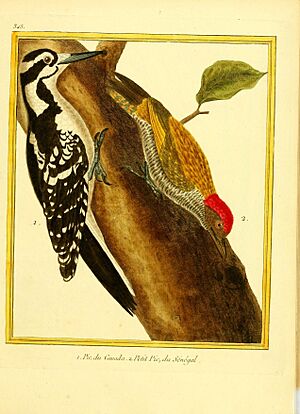Little green woodpecker facts for kids
Quick facts for kids Little green woodpecker |
|
|---|---|
 |
|
| C. maculosa on the right | |
| Conservation status | |
| Scientific classification | |
| Genus: |
Campethera
|
| Species: |
maculosa
|
The little green woodpecker (also known as the golden-backed woodpecker) is a type of bird in the woodpecker family. Its scientific name is Campethera maculosa.
You can find this bird in Africa. It likes to live in places where forests meet open areas, like forest edges and clearings. It also lives in areas with a mix of trees and bushes. Experts say this woodpecker is a "least concern" species, which means it is not currently at risk.
Contents
About the Little Green Woodpecker
What's in a Name?
Scientists give every living thing a special name. This helps everyone know exactly which animal they are talking about. The little green woodpecker was first described by a scientist named Achille Valenciennes in 1826. He first called it Picus maculosus.
There are two main types, or subspecies, of the little green woodpecker:
- C. m. maculosa: This type lives from Senegal and Guinea-Bissau to parts of Ghana.
- C. m. permista: This type is found from eastern Ghana all the way to northern Angola.
Sometimes, different types of woodpeckers can even have babies together. The little green woodpecker has been known to breed with the green-backed woodpecker in Ghana.
How to Spot a Little Green Woodpecker
The little green woodpecker is about 16 cm (6.3 in) long. That's about the length of a small ruler! It weighs around 54 g (1.9 oz), which is about the same as a small apple.
Male woodpeckers have an olive-blackish head with a bit of red. Their neck is red too. Their face and throat are a light yellowish-brown with brown spots. The top part of their body is yellowish-green or bronze-green. Their wing feathers are brown with light yellowish-brown stripes. The tail is dark, with some yellow and green.
The underside of the bird is light yellowish-brown on the throat and chest. Below the chest, it's greenish-white. All of these parts have dark olive stripes. Its beak is olive or black, its eyes are brown, and its legs are olive-grey.
Female woodpeckers look a bit different. They don't have the red on their head. Instead, their head and neck have light yellowish-brown spots. Young woodpeckers have greener upper parts and lighter stripes on their body.
Where Do They Live?
The little green woodpecker lives in West Africa. You can find it in countries like Senegal, Guinea-Bissau, Guinea, Sierra Leone, Liberia, Ivory Coast, and Ghana. If you include the permista subspecies, its home range stretches even further east. This includes places like South Sudan, Uganda, Angola, and the Democratic Republic of the Congo.
These woodpeckers love to live in certain places. They prefer the edges of forests, both old and new. They also like open areas within forests and places that have a mix of trees and bushes. They can be found at heights up to 1,000 m (3,300 ft) above sea level.
What Do They Eat and How Do They Communicate?
The little green woodpecker loves to eat ants that live in trees. It uses its strong beak to find them.
These birds make different sounds to talk to each other. Some of their calls include a sad-sounding huweeeeh, a sharp whee, a quick kewik, or three to four teeay notes. They also make a sound like teerweet.
When it's time to have babies, these woodpeckers dig out nests. They often make their nests inside the nests of ants or termites. They usually breed in August, and sometimes in March and April.
Conservation Status
Good news for the little green woodpecker! Its population seems to be growing. This might be because logging and clearing of forests create more open areas, which these birds prefer.
Because they have a large home range and their numbers are increasing, the International Union for Conservation of Nature (IUCN) has listed them as a least-concern species. This means they are not currently in danger of disappearing.


